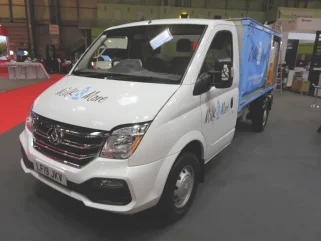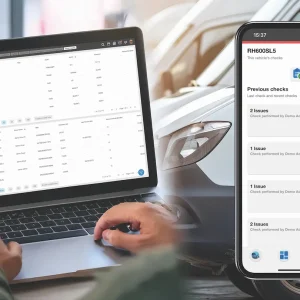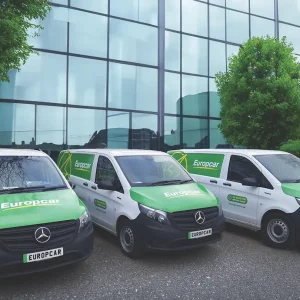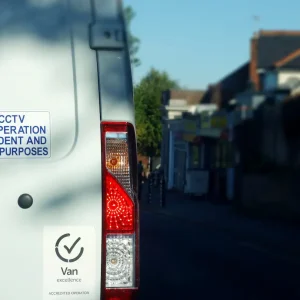
The electric LCV’s acceptance into SMEs and small fleets has been something of a stepped process – in so much that legislation has forced them onto the LCV operator. The issues of operating range and recharging infrastructure are at least (and at last) starting to be addressed whilst vehicle sourcing via lease means fixed costs and removes the risk associated with the uncertainty of residual values.
All so far so good, then, for the straight-forward panel van. The increase in GVM from 3.5-tonnes to 4.25-tonnes for both manufacturer and driving licence holder means that payloads are largely unaffected by the increased unladen mass created by the battery and there is no difficulty driving them compared to a diesel van – if you are familiar with an automatic transmission – although getting the best range requires a slightly different driving strategy. However, if you require something other than a factory fresh panel van, some complexities do arise in terms of chassis-cab or body conversions.
Experience counts
Although most LCV manufacturers offer ‘in-house’ conversions, these are more likely to be of the ‘approved supplier’ type. The reason is simple, of course – for the relatively small volumes involved, physically building such adaptations in a factory designed for mass production is impractical and very costly. For simple changes such as converting passenger vehicles to car-derived vans, the production line can cope. Hence, Toyota converts both the Corolla estate and the Land Cruiser SUV to commercials by merely omitting the rear seats and panelling the rear side windows at its UK manufacturing facility at Burnaston. However, the Proace ‘fridge van’ is a CoolKit conversion, the Hilux tipper is done by TGS and vans which require internal racking and storage are converted by Bri-Stor Systems. Toyota sells in markets across the world and using local specialists for local requirements has been its mantra for decades. With the rise of electric LCVs manufactured in China – wearing Chinese makers’ badges or others – the idea of factory ‘conversion’ becomes problematic and hence the eLCV is ripe for specialist aftermarket conversions and manufacturer approved programmes.
When it comes to conversions on eLCVs the fundamentals still apply – the conversion must not interfere with the base-vehicles’ structure, warranty parameters or significantly alter its handling attributes. However, the big elephant in the room is the propulsion, and with high voltage batteries and cables all around, the converter must be fully conversant and certified to work on such vehicles.
Then there’s the issue of the conversion itself requiring power. Tipper hydraulics are minimal, but a fully refrigerated van conversion is another matter. Here, experienced converter CoolKit has the answer. Its fridges do not draw any power from the vehicle traction battery – the high voltage would need some treatment first in any case – but they run from dedicated (and similar) lithium-ion batteries. These are recharged at the same time as the van’s main battery pack, so do not reduce the vehicle’s road range whilst operating the fridge unit. Furthermore, additional roof-mounted solar panels are an option – further increasing the running time of the refrigeration system.
CoolKit offers conversions on a multitude of eLCVs, including the Ford E-Transit, Maxus eDeliver 3 and eDeliver 9, Mercedes-Benz eVito, Renault’s Kangoo and Master E-Tech models, the Toyota Proace Electric and Vauxhall Vivaro Electric. So the role of the conversion specialist is not changing appreciably in the light of the eLCVs rise and with a simplified drivetrain and chassis or platform design it could be argued the process has been simplified, but the issue of working around high voltage batteries, cables and power units is not one to be taken lightly – the thought of re-routing cables as one might with 12V systems has no validity here. This puts the onus back onto the van manufacturer to ensure the vehicle is conversion-ready if they are to take full advantage of the opportunities the market presents.
Different manufacturers have differing views on using the traction battery for auxiliary power requirements. Where the CoolKit system is compatible with vehicle makers who allow no drawing from the traction battery, the conversions offered by Maxus do. Its eDeliver 9 uses somewhere between 3kW and 5kW of ‘spare’ capacity on the traction battery pack to power a refrigeration unit through a step-down controller. For lower-power draws, such as a tail-lift, the vehicle’s 12V auxiliary system can be used, in much the same way as that of diesel vehicles.
Of course using the main battery for other purposes will have an effect upon vehicle range, but Maxus claims this is minimal, citing that the refrigeration unit needs little more than 15 minutes run time to drop down from ambient temperature to chill or even frozen requirements and normally (certainly desirably) this will be done whilst the vehicle is still plugged-in anyway, before loading and deliveries commence. Heating the cab during a distribution round on a chilly day will actually take more from the overall range.
Stellantis also takes the view that using power from the main battery is the easiest solution, citing only 5-8% loss of range to keep a fridge running. A tail-lift or tipper of course has a smaller effect – a tipper might only tip once or twice per day and a tail-lift with a much lower power demand might only draw it half a dozen times.
Ready-made solutions
Here SAIC’s Maxus brand has already got a head start on its competitors, setting up ‘in-house’ conversion upon its Maxus eDeliver 3 and eDeliver 9 models. One
of the first conversions offered was the Maxus eDeliver 3 Milkfloat. The first electric vehicle many readers of the author’s age would have encountered as children back in the 1970s, the electric milkfloat had been operating in the UK since 1932, so there’s some natural synergy with its application for a modern eLCV when latterly the float had been replaced by open-sided Transits or single-cab pickups.
Of course the old version used simple lead-acid (car) batteries, enough for a delivery round after an 18-hour charge, whilst the Maxus boasts an official ‘city’ range of 213 miles of operation. It has a GVM of 2.6-tonnes, offering a 980kg payload and maximum speed of 56mph – more than enough and quite an increase from the old days! The more standard-looking eDeliver3 Aduro XS with twin sliding side doors offers some 151miles of mixed operating range whilst the eDeliver9 presses home the SAIC advantage. The eDeliver 9 Crew Van can seat up to nine passengers in addition to its generous cargo space. Whilst its range is 179 miles, the eDeliver chassis-cabs can offer up to 1,085kg of payload and the low-floor Luton body option means low-density large volume cargoes are no longer the preserve of diesel vehicles.
The heavy-duty side of the 3.5-tonne sector might not readily lend itself to eLCVs but even here inroads are being made. The Maxus eDeliver 9 King Tipper conversion offers a tipper body of 3,350mm long by 2,020mm wide internally with a side height of 400mm. Volume-wise, that’s ample for the 1,195kg payload to be arrived at and, with a body weight of just 347kg, its an efficient build on a 3.5-tonne chassis with an overall length of just 6.2m upon a wheelbase of 3.76m.
So the conversion sector has literally gone with the flow and the simple fact that an eLCV has one type of power for both forward motion and auxiliary equipment should mean that in-house conversions may well be the norm in years to come. Ironically the vehicle manufacturers who have had electric propulsion imposed upon them have responded to the change more readily than the governments which imposed it, the charging infrastructure still being the biggest hurdle for LCV operators to overcome.





